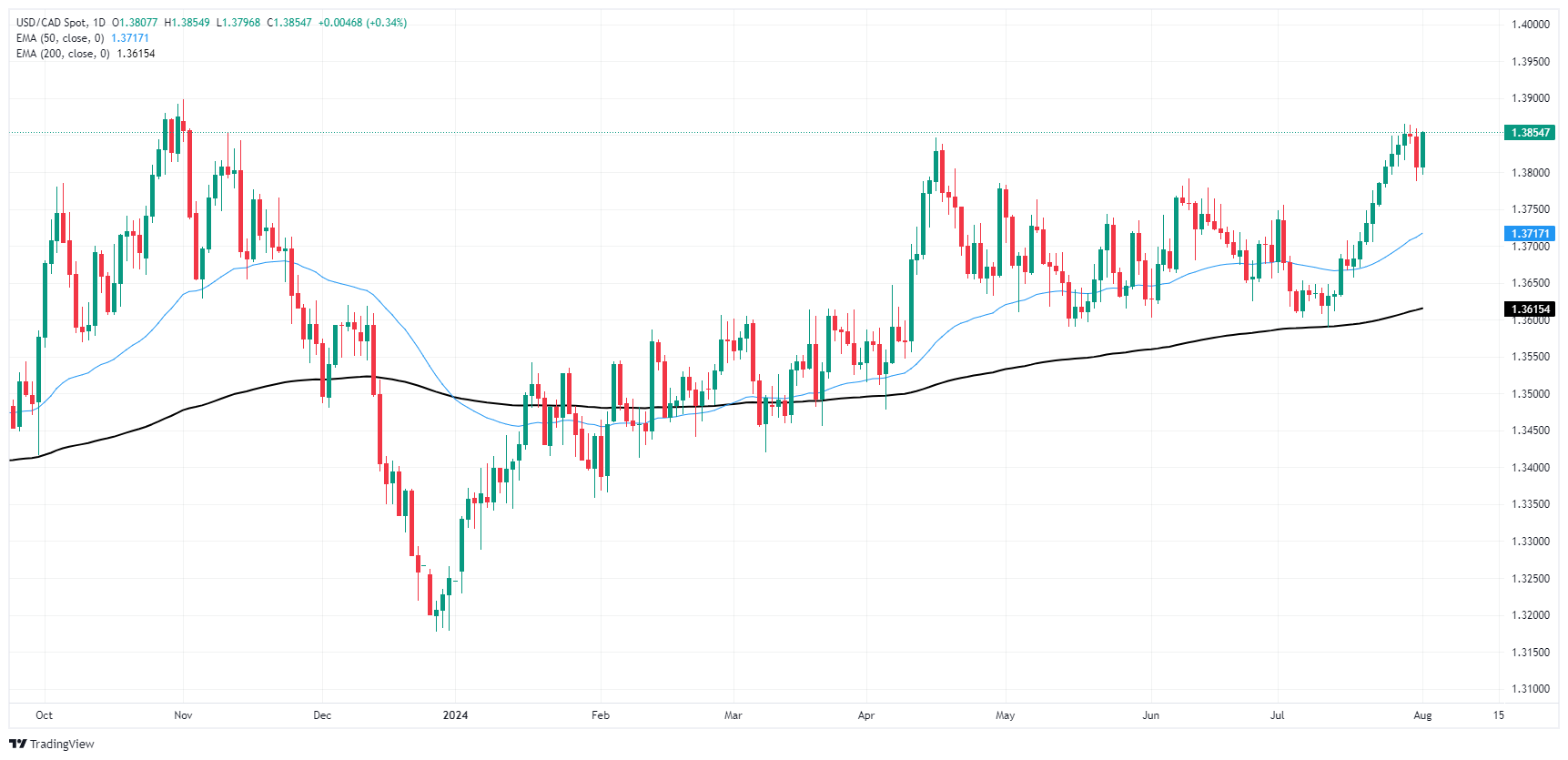- The Canadian Dollar stumbled against the US Dollar on Thursday.
- Canadian and US PMIs were soft in July.
- US NFP looms on Friday, markets expect continued softening.
He Canadian Dollar (CAD) He tripped and fell in front of the United States Dollar (USD) on Thursday following disappointing Purchasing Managers’ Index (PMI) figures that flashed warning signs of a recession risk lurking in the data, triggering a fresh round of risk-off sentiment in the market. Market flows reversed direction as investors retreated from alpha-seeking instruments and piled into safe-haven assets like the Dollar.
Canada will be sidelined as economic data will remain limited until next week’s Canadian jobs figures, with markets fully focused on the upcoming US Non-Farm Payrolls (NFP) report this Friday.
Markets continue to walk a fine line, waiting for bad economic data to kick off a cycle of rate cuts by the Federal Reserve (Fed), but not so bad that a broad economic slowdown would render rate cuts useless.
Daily Market Wrap: Canadian Dollar Loses Market Focus as US Data Dominates
- Canada’s S&P Global manufacturing PMI for July fell to a seven-month low of 47.8 from 49.3 previously as Canadian manufacturing activity continues to decline.
- The US ISM manufacturing PMI for the same period also fell to an eight-month low of 46.8 from 48.5 previously, completely missing the expected rise to 48.8 and rekindling concerns of a “hard landing” economic scenario.
- The US ISM manufacturing PMI prices paid also accelerated again in July, rising to 52.9 from 52.1 previously and reversing the expected move lower to 51.8, as inflationary pressures in the early part of the input cycle continue to turn.
- U.S. initial jobless claims also rose more than expected for the week ending July 26, rising to 249,000 week-on-week from 235,000 previously, accelerating beyond the 236,000 forecast.
- US NFP jobs data on Friday is expected to show a further slowdown in US hiring, with net job gains forecast at 175,000 compared with 206,000 previously.
Canadian Dollar PRICE Today
The table below shows the exchange rate of the Canadian Dollar (CAD) against major currencies today. The Canadian Dollar was the strongest currency against the British Pound.
| USD | EUR | GBP | JPY | CAD | AUD | NZD | CHF | |
|---|---|---|---|---|---|---|---|---|
| USD | 0.38% | 0.77% | -0.04% | 0.34% | 0.46% | -0.10% | -0.49% | |
| EUR | -0.38% | 0.39% | -0.44% | -0.05% | 0.09% | -0.48% | -0.87% | |
| GBP | -0.77% | -0.39% | -0.82% | -0.43% | -0.29% | -0.86% | -1.25% | |
| JPY | 0.04% | 0.44% | 0.82% | 0.38% | 0.51% | -0.11% | -0.48% | |
| CAD | -0.34% | 0.05% | 0.43% | -0.38% | 0.14% | -0.44% | -0.83% | |
| AUD | -0.46% | -0.09% | 0.29% | -0.51% | -0.14% | -0.57% | -0.96% | |
| NZD | 0.10% | 0.48% | 0.86% | 0.11% | 0.44% | 0.57% | -0.39% | |
| CHF | 0.49% | 0.87% | 1.25% | 0.48% | 0.83% | 0.96% | 0.39% |
The heatmap shows percentage changes of major currencies. The base currency is selected from the left column, while the quote currency is selected from the top row. For example, if you choose the Canadian Dollar from the left column and move along the horizontal line to the US Dollar, the percentage change shown in the chart will represent the CAD (base)/USD (quote).
Technical Analysis: USD/CAD rises back to 1.3850 on a short-term risk-averse bid
The Canadian Dollar (CAD) is broadly lower on Thursday, finding scant gains against the British Pound (GBP) and Australian Dollar (AUD), but losing weight against the US Dollar and Japanese Yen (JPY). The CAD is down around a third of a percent against the Dollar and Yen, while gaining roughly four-tenths of a percent against the weakened GBP.
The Canadian dollar’s respite from the US dollar’s pressure on the upside is set to be short-lived as USD/CAD bids resume a steady push higher. The pair is retesting the 1.3850 region after a mid-week dip below 1.3800. USD/CAD is testing near 2024 bid highs, set at 1.3865. Continued bullish pressure will set the pair up for a fresh challenge of last October’s swing high in the 1.3900 zone.
USD/CAD daily chart
Canadian Dollar FAQs
The key factors determining the Canadian dollar (CAD) are the level of interest rates set by the Bank of Canada (BoC), the price of oil, Canada’s main export, the health of its economy, inflation and the trade balance, which is the difference between the value of Canadian exports and its imports. Other factors include market sentiment, i.e. whether investors are betting on riskier assets (risk-on) or looking for safe assets (risk-off), with risk-on being positive for the CAD. As its largest trading partner, the health of the US economy is also a key factor influencing the Canadian dollar.
The Bank of Canada (BoC) exerts significant influence over the Canadian dollar by setting the level of interest rates that banks can lend to each other. This influences the level of interest rates for everyone. The BoC’s main objective is to keep inflation between 1% and 3% by adjusting interest rates up or down. Relatively high interest rates are generally positive for the CAD. The Bank of Canada can also use quantitative easing and tightening to influence credit conditions, with the former being negative for the CAD and the latter being positive for the CAD.
The price of oil is a key factor influencing the value of the Canadian dollar. Oil is Canada’s largest export, so the price of oil tends to have an immediate impact on the value of the CAD. Generally, if the price of oil rises, the CAD rises as well, as aggregate demand for the currency increases. The opposite occurs if the price of oil falls. Higher oil prices also tend to lead to a higher probability of a positive trade balance, which also supports the CAD.
Although inflation has traditionally always been considered a negative factor for a currency, as it reduces the value of money, the opposite has actually occurred in modern times, with the relaxation of cross-border capital controls. Higher inflation typically leads central banks to raise interest rates, which attracts more capital inflows from global investors looking for a lucrative place to store their money. This increases demand for the local currency, which in Canada’s case is the Canadian dollar.
The released macroeconomic data measures the health of the economy and can have an impact on the Canadian Dollar. Indicators such as GDP, manufacturing and services PMIs, employment and consumer confidence surveys can influence the direction of the CAD. A strong economy is good for the Canadian Dollar. Not only does it attract more foreign investment, but it can encourage the Bank of Canada to raise interest rates, which translates into a stronger currency. However, if the economic data is weak, the CAD is likely to fall.
Source: Fx Street
I am Joshua Winder, a senior-level journalist and editor at World Stock Market. I specialize in covering news related to the stock market and economic trends. With more than 8 years of experience in this field, I have become an expert in financial reporting.







